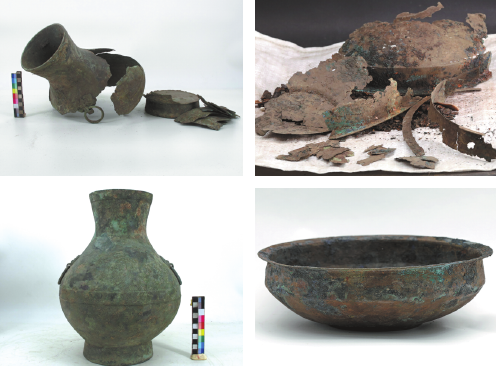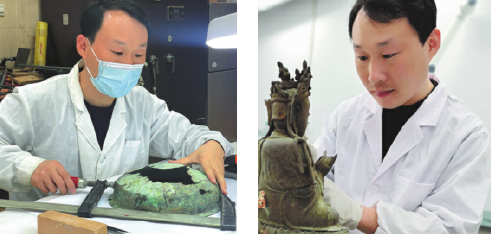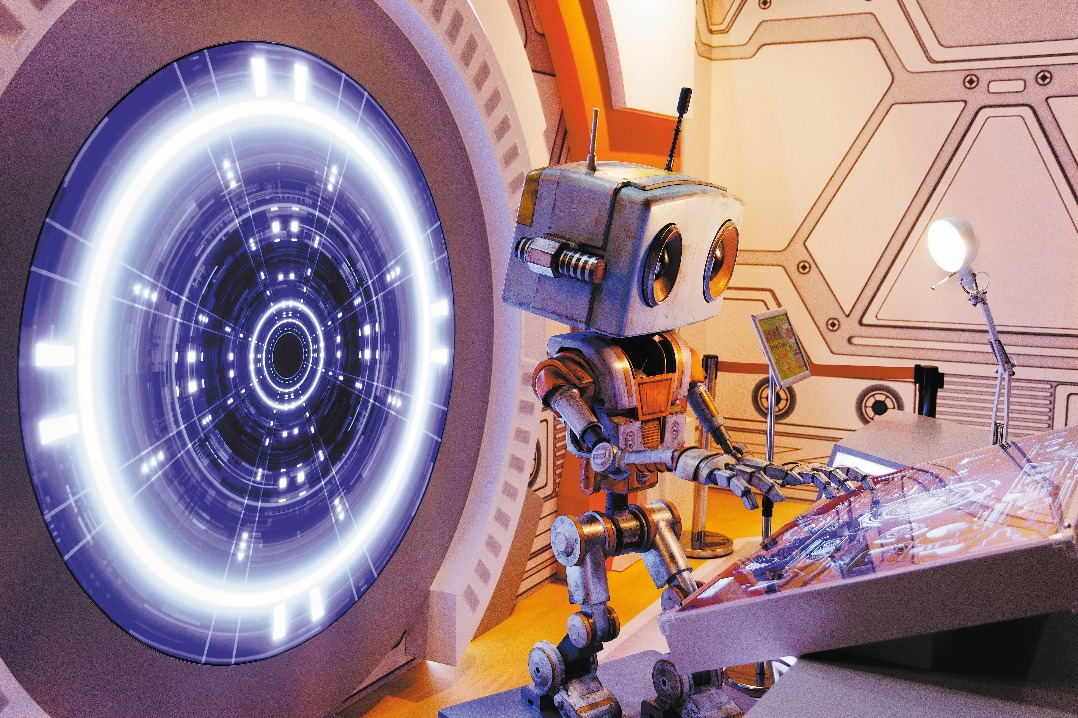GIVING THE PAST A FUTURE
Restoration expert highlights the context of his findings, Wang Ru reports.

Clad in a white coat and wielding tools akin to surgical instruments, Ren Wei describes his daily work as a practice of healing, like a doctor tending to patients.
Over the past 12 years, the relic restorer at Shandong Museum in Jinan, Shandong's provincial capital, has breathed new life into more than 3,000 cultural relics, restoring them to their former grandeur.
Each restoration project unfolds like a medical procedure, beginning with a thorough diagnosis of the artifact's condition based on information Ren and his team collect from various sources, including its weight, size and photos taken. A detailed plan for restoration will be devised after discussions. Then come meticulous procedures, such as cleaning, returning it to its original shape, and tackling corrosion.
Through a blend of traditional techniques and modern technology, Ren and his colleagues meticulously record — in both paper and digital form — every phase of the restoration process, ensuring that each relic's journey to renewal is itself well-preserved.
The restoration of a Tang Dynasty (618-907) spherical bronze censer in 2018 particularly impressed him. The ornate openwork of the censer — about the size of two clenched fists — concealed a hidden plate for sachets that was always meant to face upward regardless of the censer's movements. Yet, when it was unearthed, time had done its damage.
Engrossed in the restoration process, Ren marveled at the artifact's intricacy, a testament to the ancient craftsmen's ingenuity."The exquisiteness and wisdom woven into this piece are truly awe-inspiring," says the 41-year-old.
This tale of restoration is but one chapter in Ren's illustrious career.
He mostly works with metal artifacts unearthed in Shandong, such as gold, silver, and iron ware, and has a special affinity for the timeless allure of bronze.
The primary goal is to restore the artifacts completely in appearance so that they can be put on display and free of the corrosion that threatens them, says Ren.
Yet, just like a patient with a complex ailment, some relics bear scars too deep to fully erase. These fragile pieces require special care and environmental consideration, including temperature and humidity controls, to safeguard their delicate existence, he adds.
Historical clues
Ren emphasizes that the restoration of metal items, much like other cultural artifacts, must follow specific principles to ensure their preservation. One crucial aspect is the use of reversible measures and visible repairing materials. This approach ensures that if superior restoration methods emerge in the future, the artifacts can be further enhanced for better protection.
He also underscores the importance of a meticulous and comprehensive approach to restoration, cautioning against a narrow focus solely on the artifacts themselves.
Metal items, many of which trace their origins to ancient dynasties like the Shang (c. 16th century-11th century BC) and Zhou (c. 11th century-256 BC), carry profound historical significance, Ren explains.
"When cleaning these items, we must exercise extreme caution to avoid inadvertently erasing valuable historical information," he adds.
He recounts an instance from 2018 when he and his team were cleaning a bronze sword. While some of his colleagues focused on the rust, Ren examined hard knots on its surface and uncovered traces of wood beneath a microscope, hinting at the existence of a wooden scabbard.
"If we had concentrated on returning the artifact to its original state and removed the knots, then some valuable clues would have been erased as well," says Ren.
In addition to safeguarding the artifacts, he stresses the importance of considering the burial environment. This includes collecting and analyzing soil samples to capture vital environmental information for posterity. The approach extends to the restoration process, which often involves enduring loud noises and heavy dust due to the use of mechanical tools necessary for repairing hard metal relics.
Despite the challenging working conditions that have led some of Ren's colleagues to abandon the profession, his unwavering passion for the job fuels his commitment.
"The stories concealed within these artifacts hold greater significance for me than the temporary discomfort of noise and dust," he says.
Years ago, his team restored a Shang Dynasty bronze vessel adorned with an emblem. By consulting historical literature and cross-referencing with findings from the Yinxu Ruins in Anyang, Henan province, they uncovered compelling connections between the emblem and other patterns on Yinxu's bronze vessels.
This exploration not only enriched their own understanding of ancient cultures, but also sparked new insights into the intricate tapestry of history, Ren says.
Dedication and proficiency
Born in Zibo, Shandong, Ren graduated from Qufu Normal University in 2007 with a degree in fine arts, specializing in traditional Chinese painting. His journey into the realm of cultural heritage restoration began in 2012 when he participated in a project focused on ceramic relics in Yiyuan county, Zibo.
In 2015, he transitioned to metal relic restoration at the Shandong Museum. Through persistent practice, experiential learning, and diligent reflection, Ren, who once found himself "starting from scratch in both theory and practice", honed his skills and expertise over time.
His dedication and proficiency culminated in a remarkable achievement when he clinched the top prize at the National Vocational Skills Competition on Cultural Relics, organized by the National Cultural Heritage Administration last year.
Over the years, he has observed significant advancements in restorative materials and technologies, citing the benefits of using epoxy resin to seamlessly supplement missing parts in artifacts.
"With the evolution of materials, such as the introduction of epoxy resin, we now have safer methods to restore missing components without jeopardizing the integrity of the artifacts. This ensures that future generations can upgrade these materials without causing harm," says Ren.
Pan Lu, a researcher with the National Museum of China in Beijing, who has been devoted to restoring metal relics for four decades, also highlights the role of technology in enhancing the scientific precision of restoration efforts.
Advanced equipment enables a meticulous analysis of rust on bronze artifacts, distinguishing between harmful and benign elements with unprecedented accuracy, thereby streamlining restoration decisions, Pan explains.
The Shandong Museum has nearly 20 cultural relic restorers, including Ren, mostly born in the 1980s, who repair organic and inorganic items unearthed from the region. The team also conducts research on preventive conservation strategies to safeguard cultural treasures for future generations.
"Actually China still lacks people in this profession," says Pan. "But now more universities and colleges offer majors related to it, which is a good trend.
"Although restorers seem to polish relics all day, they actually integrate much physics, chemistry and even environmental knowledge in their practice. This means in order to protect cultural relics, they must possess broad knowledge."
After working with bronze vessels over the years, Ren has gained his own understanding of bronze culture in China.
"In many ways, bronze culture represents the glory of the ancient civilization of our country. We can witness how ancient people would sometimes mobilize the collective strength of an entire nation to make these bronze artifacts. Their craftsmanship was so refined that even modern people often struggle to replicate them," Ren says.
"Furthermore, behind the diverse vessels lies an ancient ritual system that symbolizes the pinnacle of civilization that ancient China once achieved."


Today's Top News
- Xi talks with Lula over phone
- China to extend tariff suspension on imported US products
- Joint Statement on China-US Economic and Trade Meeting in Stockholm
- More grads chart career paths in west of China
- Why China's AI initiative is critically important
- Israel's Gaza takeover plan widely condemned






























